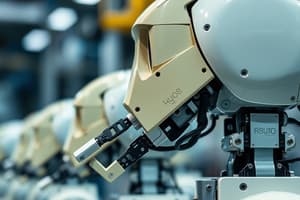Podcast
Questions and Answers
To make sure the block travels straight along the ball screw, we use_______.
To make sure the block travels straight along the ball screw, we use_______.
a guide rod
Air leaks can____.
Air leaks can____.
- All of these (correct)
- Drops in pressure
- Whip around lines
- Send chips flying
A gear used to change direction is called the_____.
A gear used to change direction is called the_____.
idler gear
Which of the following geometries is the most common due to the flexibility of the design and the fact it can replicate a wide range of human motions?
Which of the following geometries is the most common due to the flexibility of the design and the fact it can replicate a wide range of human motions?
Gear systems with______ can have both drive and driven gears on the same shaft.
Gear systems with______ can have both drive and driven gears on the same shaft.
The ISO subcategories for personal care robots are_____.
The ISO subcategories for personal care robots are_____.
The common feedback device for servomotors is the_____.
The common feedback device for servomotors is the_____.
Gear systems with _____will have the output rotating the same as the input.
Gear systems with _____will have the output rotating the same as the input.
Worm gears____.
Worm gears____.
The downside to synchronous belts is____.
The downside to synchronous belts is____.
The gear tied to the motor or power supply is called the____.
The gear tied to the motor or power supply is called the____.
Pneumatic power is often used in_____.
Pneumatic power is often used in_____.
To increase torque, we usually sacrifice____.
To increase torque, we usually sacrifice____.
Which of the following robots are often used in the electronics field, where their motion and strengths seem a good fit for the task required?
Which of the following robots are often used in the electronics field, where their motion and strengths seem a good fit for the task required?
We call two gears on the same shaft a_____.
We call two gears on the same shaft a_____.
Early robots and applications where there are other means of verifying position commonly use______.
Early robots and applications where there are other means of verifying position commonly use______.
For proper operation, the______ and ______of a gear should match.
For proper operation, the______ and ______of a gear should match.
Gear systems with_____ will have the output rotating opposite the input.
Gear systems with_____ will have the output rotating opposite the input.
Which of the following geometries has the benefits of moving materials over large distances and saving floor space by mounting over the equipment?
Which of the following geometries has the benefits of moving materials over large distances and saving floor space by mounting over the equipment?
Hypoid gears can_____.
Hypoid gears can_____.
We typically change hydraulic oil_____.
We typically change hydraulic oil_____.
A bevel gear set can rotate the force between______ degrees.
A bevel gear set can rotate the force between______ degrees.
The gear tied to the output is called the____.
The gear tied to the output is called the____.
Which of the following geometries has the benefits of being good for reaching deep into machines, saving on floor space, and tending to have the rigid structure needed for large payloads?
Which of the following geometries has the benefits of being good for reaching deep into machines, saving on floor space, and tending to have the rigid structure needed for large payloads?
When a Cartesian robot has only two major axes, what is the common axis left out?
When a Cartesian robot has only two major axes, what is the common axis left out?
Flashcards are hidden until you start studying
Study Notes
Robot Classification and Components
- Guide Rod: Ensures straight travel of the block along the ball screw.
- Air Leaks: Can lead to multiple issues such as sending chips flying, creating pressure drops, and causing whipping around lines.
- Idler Gear: A gear specifically used to change the direction of movement in a system.
- Articulate Robots: Most common geometry for robot design due to their flexibility and ability to replicate a wide range of human motions.
Gear Systems
- Compound Gear: Gear systems using compound gears can accommodate both drive and driven gears on the same shaft.
- Synchronization of Gears: Systems with an odd number of gears have output rotating in sync with input; even numbers result in opposite rotations.
- Drive Gear: The gear directly connected to the motor or power supply, while the driven gear is the output gear.
- Worm Gears: Not only simpler than bevel gears, they can provide torque ratios as high as 500:1 and can lock in place.
Robots and Applications
- Personal Care Robots: Classified under ISO subcategories including mobile servant, physical assistant, and personal carrier robots.
- SCARA Robots: Particularly effective in the electronics industry due to their precise motion and strength.
- Early Robots: Often utilize stepper motors in applications where there are alternate means of verifying position.
Maintenance and Operation
- Pneumatic Power: Commonly employed in robotic tooling applications for efficient operations.
- Torque vs. Speed: Increasing torque generally requires a reduction in speed for proper functioning.
- Hydraulic Oil: Typically changed once a year to maintain operational efficiency.
Gear Mechanics
- Feedback Device: Encoders serve as the common feedback device for servomotors ensuring accurate positioning.
- Bevel Gear Capacity: A bevel gear set allows for force rotation within a range of 0 to 180 degrees.
- Hypoid Gears: Capable of generating significant gear ratios, up to 60:1, for various applications.
Robot Geometries
- Cartesian Robots: Excel at moving materials over large distances and are designed to save floor space through overhead mounting.
- Cylindrical Robots: Effective for accessing deep machinery while being designed for large payloads and maintaining a rigid structure.
- Missing Axis in Cartesian Robots: When only two major axes are present, the typical excluded axis is the X-axis.
Studying That Suits You
Use AI to generate personalized quizzes and flashcards to suit your learning preferences.




